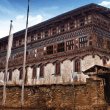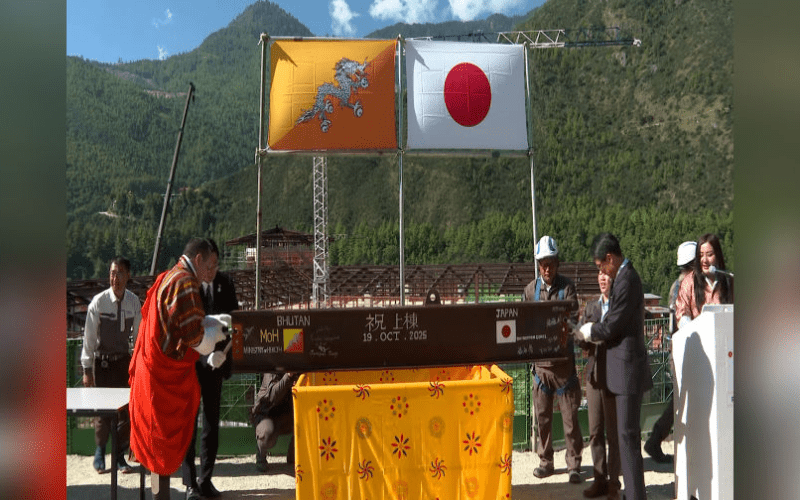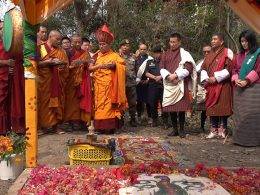The serene hills of Gidakom echoed with celebration today as the Royal Centre for Infectious Diseases (RCID) reached a major construction milestone. A traditional Japanese topping-out ceremony was held to mark the placement of the final beam atop the structure — a ritual symbolizing good fortune, gratitude, and prayers for the continued safety of the workers.
As the morning light filtered through the trees, the chirping of birds accompanied a quiet purification ceremony that set a solemn yet joyous tone. Soon after, project officials, engineers, and workers who had been part of the effort since August last year took turns signing the steel beam — their names etched in recognition of a shared journey.
With the final beam lifted and secured at the building’s peak, the RCID’s main structure now stands complete. For Project Manager Takeharu Kakeya of Dai Nippon Construction, the ceremony carried deep meaning.
“We believe in God. After completing the concrete and steel structure, we pray for safety and a smooth finish. This ritual is for the protection of our workers and the success of the project,” he said.
Expected to be completed by June next year, the RCID will coincide with the 40th anniversary of diplomatic relations between Bhutan and Japan. The project — valued at Nu 2.2 billion — is the largest grant assistance undertaken by the Japan International Cooperation Agency (JICA) in Bhutan’s development history.
Once operational, the RCID will serve as the nation’s primary hub for the treatment, prevention, and management of infectious diseases such as COVID-19 and tuberculosis. It will also function as a national training facility for healthcare professionals.
Ambassador of Japan to Bhutan Keiichi Ono described the project as a joint investment in preparedness and resilience.
“This is an important project for both countries. We have learned from the COVID-19 experience and are preparing for future pandemics together,” he said.
Echoing this sentiment, Health Minister Tandin Wangchuk noted the centre’s role in fortifying Bhutan’s health system.
“We never know when the next pandemic will strike, but we know it is inevitable. This centre will not only enhance our response capacity but also provide advanced training for our health professionals,” he stated.
The RCID is designed to accommodate 80 beds under normal conditions, expandable to 100 beds in emergencies. It is expected to become a cornerstone in Bhutan’s public health infrastructure, capable of responding swiftly to disease outbreaks.
Kimata Yoichiro, Chief Representative of JICA Bhutan Office, outlined three core purposes for the facility:
“It will strengthen medical education through collaboration with KGUMSB, improve treatment for infectious diseases like TB, and enhance Bhutan’s preparedness in the event of another pandemic,” he said.
With 56 percent of construction already complete, slightly ahead of schedule, the Royal Centre for Infectious Diseases stands as a powerful symbol of friendship and shared commitment between Bhutan and Japan — a partnership dedicated to safeguarding lives and building a healthier future for all.








